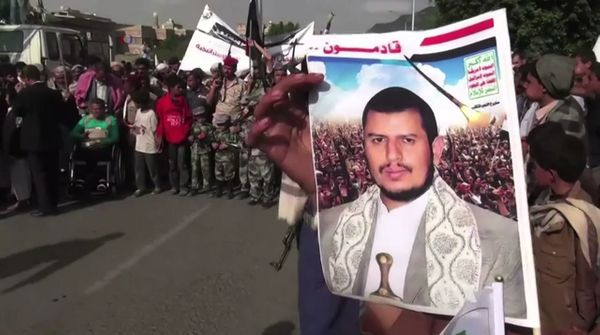Yemen has been emaciated by a war between the home-grown Houthi rebels and a military coalition led by Saudia Arabia and United Arab Emirates. While, the Saudi-UAE coalition has carried out more than 18000 raids in the span of 4 years (since the beginning of the conflict in 2015), the Yemeni Houthis have recently stepped up with missile and drone attacks on Saudi targets, the latest being, the attacks on the Khurais oil field that is estimated to produce over 10 lakh barrels of crude oil in a day.

Here we will talk about the Houthis – Their Origin, History, their role in Yemen’s Civil War and their ongoing conflict with Saudi and Arab Coalition –
The Origin – Who
are the Houthis?
The Zaidis were a powerful force in northern regions of Yemen but were put on the back burner during the North Yemen Civil War (1962-70). Next they were side-lined in the 80s as the Sunni ideals gained eminence throughout the Saudi border, which then disseminated its ideology to Yemen. In its response to Saudia Arabia and its allies, the Zaidi clerics started to militarise its followers and they gained support from Yemeni Shias who were fed up of the massive corruption going on during the supremacy of Ali Abdullah Saleh, the President and Saudi ally. This gave birth to the anti-Saudi resistance group popularly known as Houthi rebels or Houthis.
The Houthi movement also known as Ansar Allah was founded and started in Sa’dah in 90s under the leadership of Hussein Badreddin al-Houthi, son of Zaidi cleric and a prominent member of Yemen’s Zaidi Shia minority. Hussein (45) was killed in the 2004 Houthi insurgency by Yemeni soldiers. The group is now led by his youngest brother Abdul Malik Badreddin al-Houthi. It is under’s Abdul-Malik’s leadership that the group is called as Houthi rebellion. Two of Abdul Malik’s brother – Yahia Badreddin al-Houthi and Abdul Karim al-Houthi too are the leaders of the Houthi movement.
The Start of
the Houthi-Saudi Conflict (The Houthi Insurgency 2004-2010)
Even after the death of Hussein the insurgency continued as his brother Abdul-Malik continued the fight with President Ali Abdullah Saleh’s army and air force. However, in October 2009 the entire fight took an International turn when clashes were reported between the Houthi rebels and Saudi security forces, post which they took full control of Yemen-Saudi mountainous border region of Jabal al-Dukhan along with two villages in the Saudi region. The Houthis had always accused Saudi Arabia of supporting the Yemen government against them. Next, the Saudi joined the anti-Houthi campaign and thus started the Houthi-Saudi conflict.
On November 5, 2009, Saudi launched heavy air strikes on the Yemeni rebels in North Yemen and moved its border near the border. The air strikes by Saudi continued in December too as alleged by the Houthi. In January, 2010, the Houthis offered a truce as a gesture of peace since civilians were dying in the cross-fire. The Saudi general even confirmed that Houthi rebels had stopped fighting and they entered a truce. The Yemeni government too offered a conditional cease-fire with the Houthis which they agreed upon. However, despite the cease-fire agreement there were clashes between the rebels, Yemen and Saudi forces. The government of Yemen rejected the truce and started its fresh air strikes on the Houthi rebels.
Houthis Power
Control Post Yemeni Revolution
The Houthi rebellions participated in the Yemeni revolution that started in January 2011. As the revolution continued the Houthis gained control of more territory in Yemen. When dissent and assassination attempts compelled President Saleh to resign in 2012, Houthis, being the only revolutionary group with military experience, got control of regions even outside their northern territory.
By May 2012, Houthis reportedly controlled majority of Al Jawf, Hajjah, Saada governorates and also got access to the Red Sea. Next, they started initiating barricades towards the north of Sanaʽa to prepare for more fight. By 21 September 2014, Houthis controlled parts of Yemeni capital, Sanaʽa including government buildings and a radio station.
Also Read: Yemen Civil War: 10 Things You Need to Know
Post 2015: Houthis Vs New
President + Saudi-Coalition
After the downfall of President Saleh, the Houthi rebels grew more powerful and so they pulled out of transition talks aimed at creating a new and stable Yemeni government. In fact, in January 2015 they allied with their past enemy Saleh and seized Sana’a, the Yemeni capital by ousting the new president, Abd Rabbu Mansour Hadi.
On February 6, 2015, the Houthis dissolved the parliament and declared themselves in full control of Yemen by putting a Revolutionary Committee controlled and commanded by Mohammed Ali al-Houthi. The president who was put on house arrest by Houthis however escaped on February 21, made his way to Aden. On reaching Aden, Hadi not only condemned the takeover by Houthis but also renounced his resignation and even attempted to reassemble his government by declaring Aden to be Yemen’s provisional capital.
Next, Abd Rabbu Mansour Hadi seeded military support from Saudia Arabia and Saudi in 2015 readily launched an intervention in Yemen leading to an Arab coalition of nine countries from Africa and Middle East against the Houthis. The conflict is still on and the Houthi rebels have stepped up with drone as well as missile attacks as part of their combat strategy.

